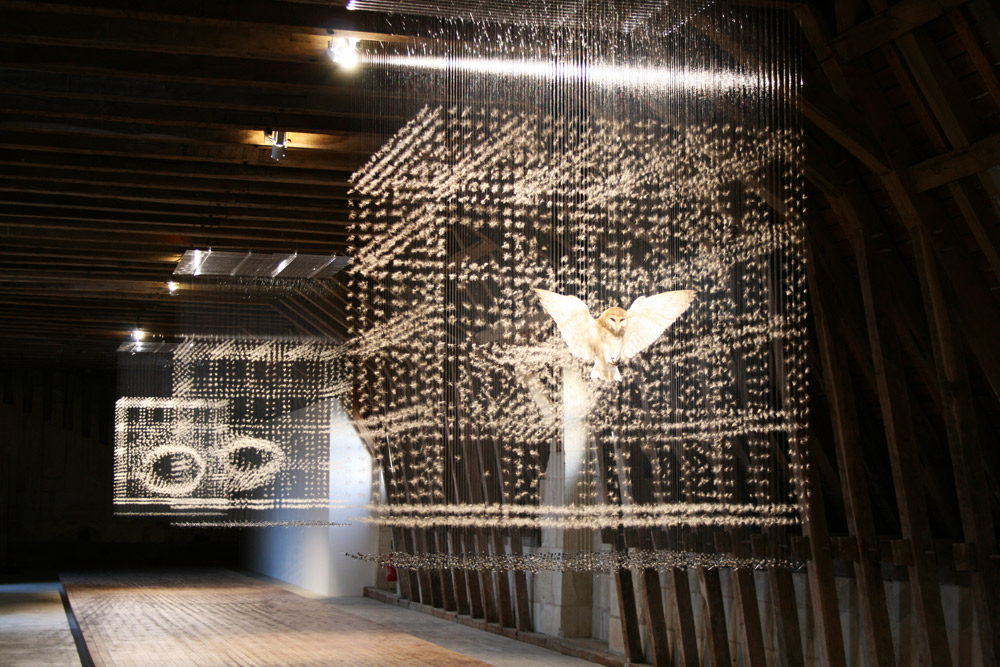TLM10: CLAIRE MORGAN
“What scares me is our relationship with nature: our unwillingness to see ourselves as part of nature—which is of course the case, being just another species of mammal, albeit a rather prolific one,” says the artist Claire Morgan, whose work is often about the tenuous and uneasy relationship between people, their environment, and the other species with which they share it. Her best-known works are elaborate, spectacular, and often sensational, at first glance resounding with traces of the polemicism of the largely London-based YBA’s of the late Nineties and early Aughts—artists like Jake and Dinos Chapman and Damien Hirst, who were known for their expansive and abstract installations incorporating either faux or authentic organic materials and (notoriously, in Hirst’s case) taxidermy.
Morgan, who was born in Belfast and now lives and works in London, came of age in the shadow of those giants. Nevertheless, her work has a gentler, more humanistic touch than that of her antecedents. Her practice is split between intricate “blood drawings”—preparatory exercises for her spectacular, large-format sculptures—in which precise graphite marks more befitting an architect’s plans commingle with fluids and viscera from the animals she manipulates and preserves, and the sculptures themselves, which incorporate taxidermied birds and small animals suspended within a floating, three-dimensional framework: a grid of glittering, pointillist dots painstakingly installed in the form of Platonic geometries.
Morgan “began working with suspended materials first,” she admits. “The very nature of the materials—thousands of individual elements hanging in space—not connected but forming something seemingly solid, has a great metaphorical resonance for me. The physicality of the suspension gives the sense of a state between movement and stillness, and I’m interested in the potential that can be felt, the potential energy, the gravity, the possibility of change, and the frailty that comes with that.” The presence of these very organic materials, animals that grew and developed and died (often violently—Morgan works almost exclusively with specimens that were victims of cats or cars), suspended within the precise confines of a Cartesian calculus, makes for a riveting, and surprisingly emotional, tableau. And while Morgan initially was fascinated by the passage of time, and featured decomposing animal material in her pieces— “in outdoor (or well-ventilated) settings”—as the years inexorably passed she became increasingly fascinated by “ideas of attempting to control or arrest time or change, as opposed to watching it occur. The interest in, and the need to learn, taxidermy, developed alongside this quite organically.”
“I most enjoy working with corvids,” Morgan adds, of the passerine family of birds that includes jackdaws, ravens, and rooks. “They’re very beautiful, so I appreciate the opportunity to handle, study, and draw them. I’m also fascinated by their intelligence and behavior, and their proximity to us, which is why I include them in my work.”
Her art is also heavily process-based. “I don’t like taking short cuts,” she insists. “Evidence of labor is important, because I think it introduces another aspect to the relationship people have with the pieces,” she notes. Morgan’s process seems to straddle a delicate line between the deeply personal and the universal, a balance that tips toward individual experience, and which allows for an intimate viewing experience (despite the scale and intricacy of her sculptures), thanks to the craftsmanship the artist painstakingly applies to each individual piece.
“The taxidermy of course introduces a whole host of other knowledge and techniques that I need to master—skinning and tanning, understanding anatomy, carving wood, and so on,” she adds. “I need my work to remain challenging for me practically, and in this area I am still very much in the process of developing my skills. From an emotional perspective, having direct contact with an individual dead animal, and exploring the physical, carnal nature of it, seeing the traces of its death, impacts my understanding of it.”
Anyone who’s had the pleasure of encountering Morgan’s work in person can attest to its alarming, elaborate precision, as well as its direct emotional impact. One can only imagine how that force will be enhanced by a series of planned works involving larger species. “One of my next pieces will involve a fox, and I have another plan for a muntjac deer, though I can only work with the specimens I have, and it’s difficult to know if my attempts will be successful when first encountering the anatomy and unique problems of a new species,” Morgan says.
For those of us caught alongside her in the river of time and the confines of the natural world, it will be worth the wait to find out.
All images courtesy of the artist and Galerie Karsten Greve, Cologne, Paris, St. Moritz.




















